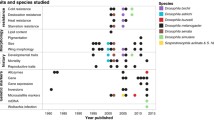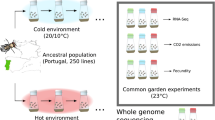Abstract
Understanding the significance of electrophoretic variation is of interest for both ecological and evolutionary genetics. Although there has been a very active neutralist–selectionist debate about the patterns of electrophoretic variation in natural populations, it is only recently that charged amino acids have been shown to be important in enzyme adaptation. In this study we carried out a broad electrophoretic survey of amylase variation in 150 species of Drosophilids. The distribution of amylase electromorphs was found to be correlated with the geographical origin of the flies. Generally the faster migrating variants are found in warmer temperatures. There is also a correlation with the feeding habits of the species, in particular, fungus feeders consistently showed a deviating pattern of electrophoretic mobility. These correlations between ecological diversity and electrophoretic patterns indicate that at least some of the changes in charged amino acids are adaptive, and result from selection to cope with specific environments.
Similar content being viewed by others
References
Beintema, J.J., 1990. The primary structure of langur (Presbytis entellus) pancreatic ribonuclease: adaptive features in digestive enzymes in Mammals. Mol. Biol. Evol. 7: 470–477.
Benkel, B.F. & D.A. Hickey, 1986. The interaction of genetic and environmental factors in the control of amylase gene expression in Drosophila melanogaster. Genetics 114: 943–954.
Cariou, M.-L., D. Lachaise, J. Sourdis, L. Tsacas, C. Krimbas & M. Ashburner, 1988. New African species in the Drosophila obscura species group: genetic variation, differentiation and evolution. Heredity 61: 73–84.
Da Lage, J.-L., M.-L. Cariou & J.R. David, 1989. Geographical polymorphism of amylase in Drosophila ananassae and its relatives. Heredity 63: 67–72.
Da Lage, J.-L., A. Klarenberg & M.-L. Cariou, 1996. Variation in sex-, stage-and tissue-specific expression of the amylase genes in Drosophila ananassae. Heredity 76: 9–18.
Daïnou, O., M.-L. Cariou, J.R. David & D. Hickey, 1987. Amylase gene duplication: an ancestral trait in the Drosophila melanogaster species subgroup. Heredity 59: 245–251.
Daïnou, O., M.-L. Cariou, J.M. Goux & J.R. David, 1993. Amylase polymorphism in Drosophila melanogaster: haplotype frequencies in tropical African and American populations. Genet. Sel. Evol. 25: 133–151.
D'Amico, S., C. Gerday & G. Feller, 2001. Structural determinants of cold adaptation and stability in a large protein. J. Biol. Chem. 276: 25791–25796.
De Jong, G. & W. Scharloo, 1976. Environmental determination of selective significance or neutrality of amylase variants in Drosophila melanogaster. Genetics 84: 77–94.
De Jong, G., A.J.W. Hoorn, G.E.W. Thorig & W. Scharloo, 1972. Frequencies of amylase variants in Drosophila melanogaster. Nature 238: 453–454.
Demetrius, L., 1997. Selective neutrality and enzyme kinetics. J. Mol. Evol. 45: 370–377.
Dennis, P.P. & L.C. Shimmin, 1997. Evolutionary divergence and salinity-mediated selection in halophilic archaea. Microbiol. Mol. Biol. R. 61: 90–104.
Doane, W.W., 1969. Drosophila amylases and problems in cellular differentiation, pp. 73–109 in Problems in Biology: RNA in development, edited by E.W. Hanly. University of Utah Press.
Feller, G., F. Payan, F. Theys, M. Qian, M. Haser & C. Gerday, 1994. Stability and structural analysis of α-amylase from the antarctic psychrophile Alteromonas haloplanctis A23. Eur. J. Biochem. 222: 441–447.
Genicot, S., F. Rentier-Delrue, D. Edwards, J. VanBeeumen & C. Gerday, 1996. Trypsin and trypsinogen from an Antarctic fish: molecular basis of cold adaptation. Biochim. Biophys. Acta 1298: 45–57.
Goto, S.G., H.W. Kitamura & M.T. Kimura, 2000. Phylogenetic relationships and climatic adaptations in the Drosophila takahashii and montium species subgroups. Mol. Phylogenet. Evol. 15: 147–156.
Hickey, D.A., 1977. Selection for amylase allozymes in Drosophila melanogaster. Evolution 31: 800–804.
Hickey, D.A., 1979. The geographical pattern of an enzyme polymorphism in D. melanogaster. Genetica 51: 1–4.
Hochachka, P.W. & G.N. Somero, 1984. Biochemical Adaptation. Princeton University Press, Princeton, NJ.
Hoorn, A.J.W. & W. Scharloo, 1978. The functional significance of amylase polymorphism in Drosophila melanogaster. I. Properties of two amylase variants. Genetica 49: 173–180.
Inomata, N. & T. Yamazaki, 2000. Evolution of nucleotide substitutions and gene regulation in the amylase multigenes in Drosophila kikkawai and its sibling species. Mol. Biol. Evol. 17: 601–615.
Inomata, N., K. Kanda, M.-L. Cariou, H. Tachida & T. Yamazaki, 1995a. Evolution of the response patterns to dietary carbohydrates and the developmental differentiation of gene expression of α-amylase in Drosophila. J. Mol. Evol. 41: 1076–1084.
Inomata, N., H. Shibata, E. Okuyama & T. Yamazaki, 1995b. Evolutionary relationships and sequence variation of α-amylase variants encoded by duplicated genes in the Amy locus of Drosophila melanogaster. Genetics 141: 237–244.
Kikkawa, H., 1964. An electrophoretic study on amylase in Drosophila melanogaster. Jpn. J. Genet. 39: 401–411.
Kimura, M.T., 1988. Adaptations to temperate climates and evolution of overwintering strategies in the Drosophila melanogaster species group. Evolution 42: 1288–1297.
Lachaise, D., P. Capy, M.-L. Cariou, D. Joly, F. Lemeunier & J.R. David, 2003. Nine relatives from one African ancestor: the population biology of the Drosophila melanogaster subgroup species, in The Evolution of Population Biology-Modern Synthesis, Vol. 3, edited by R. Singh, S. Jain, M. Uyenoyama & L. Festschrift. Cambridge University Press, Cambridge (in press).
Lemeunier, F., S. Aulard, M. Arienti, J.M. Jallon, M.L. Cariou & L. Tsacas, 1997. The ercepeae complex: new cases of insular speciation within the Drosophila ananassae species subgroup (melanogaster group) and descriptions of two new species (Diptera: Drosophilidae). Ann. Entomol. Soc. Am. 90: 28–42.
Matsuo, Y. & T. Yamazaki, 1984. Genetic analysis of natural populations of Drosophila melanogaster in Japan. IV. Natural selection on the inducibility, but not on the structural genes, of amylase loci. Genetics 108: 879–896.
Milanovic, M., M. Andjelkovic & G. Stamenkovic-Bojic, 1989. Adaptive significance of amylase polymorphism in Drosophila. IV. A comparative study of biochemical properties of the alphaamylase in Drosophila melanogaster, D. hydei, D. subobscura, and D. busckii. Comp. Biochem. Phys. 93B: 629–634.
Okuyama, E., H. Shibata, H. Tachida & T. Yamazaki, 1996. Molecular evolution of the 5_-flanking regions of the duplicated Amy genes in Drosophila melanogaster species subgroup. Mol. Biol. Evol. 13: 574–583.
Powell, J.R. 1997. Progress and Prospects in Evolutionary Biology. The Drosophila model. Oxford University Press, Oxford.
Prager, E.M., 1996. Adaptive evolution of lysozyme: changes in amino acid sequence, regulation of expression and gene number, pp. 323–345 in Lysozymes: Model Enzymes in Biochemistry and Biology, edited by P. Jollès. Birkhäuser, Basel, Switzerland.
Prigent, S., M. Matoub, C. Rouland & M.-L. Cariou, 1998. Metabolic evolution in α-amylases from Drosophila virilis and D. repleta, two species with different ecological niches. Comp. Biochem. Phys. 119B: 407–412.
Rice, W.R., 1989. Analysing tables of statistical tests. Evolution 43: 223–225.
Rio, B., G. Couturier, F. Lemeunier & D. Lachaise, 1983. Evolution d'une spécialisation saisonnière chez Drosophila erecta (Dipt., Drosophilidae). Ann. Soc. Entomol. Fr. (N.S.) 19: 235–248.
Shibata, H. & T. Yamazaki, 1994. A comparative study of the enzymological features of α-amylase in the Drosophila melanogaster species subgroup. Jpn. J. Genet. 69: 251–258.
Shibata, H. & T. Yamazaki, 1995. Molecular evolution of the duplicated Amy locus in Drosophila melanogaster species subgroup: concerted evolution only in coding region and excess of nonsynonymous substitutions in speciation. Genetics 141: 223–236.
Shirai, T., A. Suzuki, T. Yamane, T. Ashida, T. Kobayashi, J. Hitomi & S. Ito, 1997. High-resolution crystal structure of M-protease: phylogeny aided analysis of the high-alkaline adaptation mechanism. Protein Eng. 10: 627–634.
Singh, R.S., D.A. Hickey & J. David, 1982. Genetic differentiation between geographically distant populations of Drosophila melanogaster. Genetics 101: 235–256.
Spicer, G.S. & J. Jaenike, 1996. Phylogenetic analysis of breeding site use and α-amanitin tolerance within the Drosophila quinaria species group. Evolution 50: 2328–2337.
Tadlaoui-Ouafi, A., 1993. Evolution structurale et moléculaire de la famille multigénique Amylase chez quelques Drosophilidae. PhD Thesis, Université Pierre et Marie Curie, Paris.
Throckmorton, L., 1975. The phylogeny, ecology and geography of Drosophila, pp. 421–469 in Handbook of Genetics, Vol. 3, edited by R.C. King. Plenum Press, New York.
Tomazic, S.J. & A.M. Klibanov, 1988. Why is one Bacillus α-amylase more resistant against irreversible thermoinactivation than another? J. Biol. Chem. 263: 3092–3096.
Watt, W.B., K. Donohue & P.A. Carter, 1996. Adaptation at specific loci. VI. Divergence vs. parallelism of polymorphic allozymes in molecular function and fitness-component effect among Colias species (Lepidoptera, Pieridae). Mol. Biol. Evol. 13: 699–709.
Wheeler, M.R., 1981. The Drosophilidae: a taxonomic overview, pp. 1–97 in The Genetics and Biology of Drosophila, Vol. 3a, edited by M. Ashburner, H. Carson & J.N. Thompson. Academic Press, London and New York.
Wheeler, M.R., 1986. Additions to the catalog of the world's Drosophilidae, pp. 395–409 in The Genetics and Biology of Drosophila, Vol. 3e, edited by M. Ashburner, H. Carson & J.N. Thompson. Academic Press, London and Orlando.
Zhang, Z., N. Inomata, M.-L. Cariou, J.-L. Da Lage & T. Yamazaki, 2003. Phylogeny and evolution of the amylase multigenes in the Drosophila montium species subgroup. J. Mol. Evol. 56: 121–130.
Author information
Authors and Affiliations
Corresponding author
Rights and permissions
About this article
Cite this article
Prigent, S., Renard, E. & Cariou, ML. Electrophoretic Mobility of Amylase in Drosophilids Indicates Adaptation to Ecological Diversity. Genetica 119, 133–145 (2003). https://doi.org/10.1023/A:1026071317995
Issue Date:
DOI: https://doi.org/10.1023/A:1026071317995




